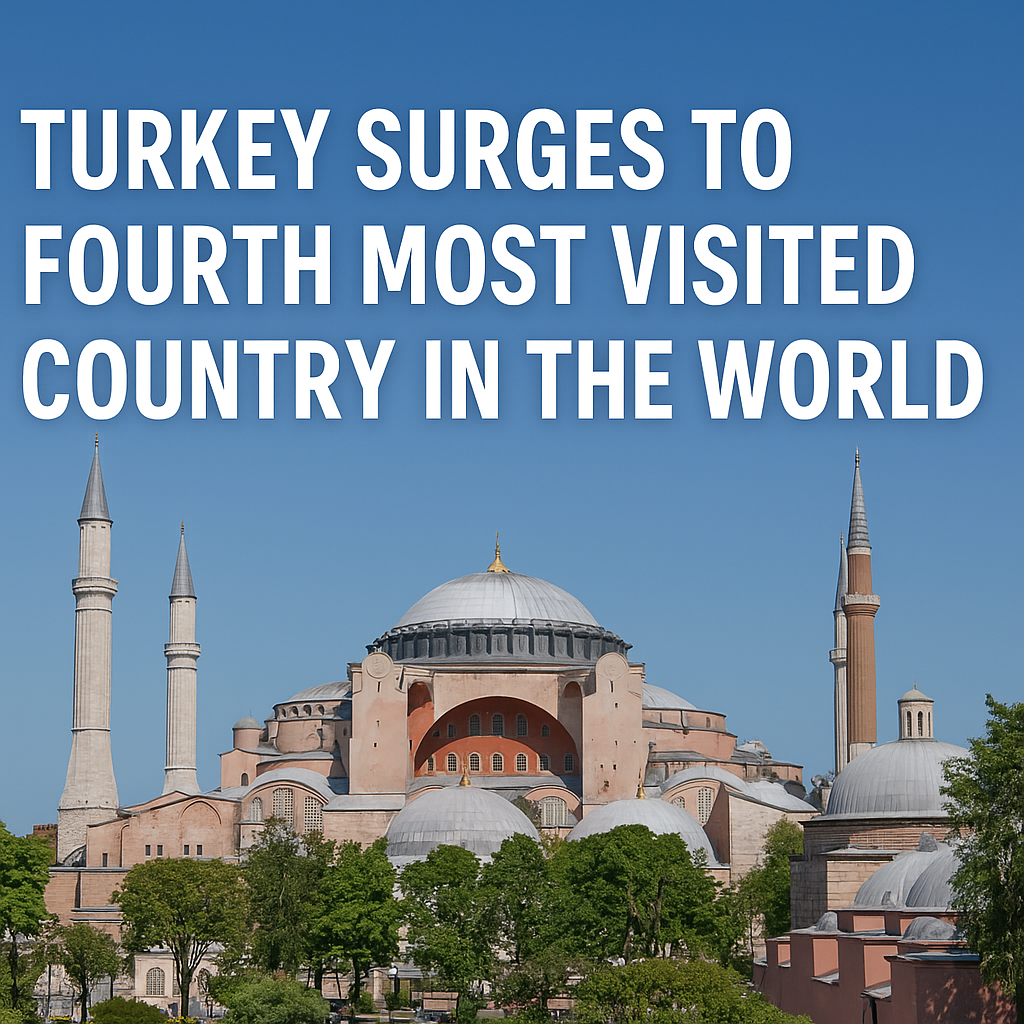In a record-breaking performance, Turkey welcomed over 60 million international tourists in 2024, placing it as the fourth most visited country in the world, according to the latest United Nations World Tourism Organization (UNWTO) “World Tourism Barometer” report. This impressive feat catapulted Turkey ahead of leading travel destinations such as Mexico, Germany, the UK, Japan, Greece, Thailand, Canada, Morocco, Egypt, and South Africa—all long-established tourism magnets.
Turkey’s monumental rise underscores its emergence as a global tourism powerhouse, fueled by its strategic location, diversified attractions, modern infrastructure, and strong promotional strategies. Only France, Spain, and the United States ranked higher, making Turkey the leading destination in the Middle East and Mediterranean basin.
What’s Driving Turkey’s Tourism Boom?
Turkey’s success in surpassing ten major global tourism competitors is rooted in several unique strengths:
- Geographic Advantage: Sitting at the crossroads of Europe and Asia, Turkey is within a short flight from three continents, making it an accessible destination for tourists across Europe, the Middle East, Central Asia, and North Africa.
- Visa Facilitation: Turkey’s extensive visa-free and eVisa agreements have simplified entry procedures for millions of travelers.
- Year-Round Appeal: From beach getaways on the Turkish Riviera to cultural escapades in Istanbul and ski resorts in Erzurum, Turkey offers four-season tourism for every interest and budget.
- Robust Infrastructure: State-of-the-art airports like Istanbul Airport—one of the world’s largest—paired with upgraded highways, regional airports, and a growing high-speed rail network have streamlined travel across the country.
- Aggressive Promotion: Campaigns by the Ministry of Culture and Tourism, in collaboration with influencers and media, have strategically positioned Turkey as a top global travel destination.
How Turkey Outpaced Traditional Leaders
Mexico: 45 Million Visitors
Mexico, known for its Caribbean coastline and rich heritage, recorded 45 million international tourists. Yet, Turkey’s more diverse geography, safety perception, and access to European and Asian markets helped it edge out Mexico by 15 million visitors.
Germany: 37.5 Million Visitors
Despite strong inbound travel to cities like Berlin and Munich, Germany’s cooler climate and higher travel costs gave Turkey the edge. Affordable pricing and warmer weather attracted over 23 million more tourists to Turkey.
United Kingdom: 39.4 Million Visitors
London continues to be a magnet, but Brexit-related uncertainties and elevated travel costs limited growth. Turkey’s cost-effective and family-friendly options helped it outpace the UK by over 21 million.
Japan: 36.9 Million Visitors
Japan excels in hospitality and cultural allure but remains a long-haul destination for many. In contrast, Turkey’s central location and similar cultural depth drew nearly 24 million more visitors.
Greece: 36 Million Visitors
Greece and Turkey share a Mediterranean charm, but Turkey’s broader landmass, larger tourism capacity, and lower pricing allowed it to pull ahead by 25 million visitors.
Thailand: 39.8 Million Visitors
Thailand’s vibrant tourism sector was strong, but Turkey’s edge came from its proximity to key global tourism markets and a wider seasonal spread.
Canada: 20 Million Visitors
Though rich in natural beauty, Canada’s travel distances and cold weather posed challenges. Turkey’s all-season, compact, and well-connected attractions proved more appealing.
Morocco, Egypt, and South Africa
Turkey outpaced Morocco (17.4M), Egypt (15.7M), and South Africa (8.9M) by tens of millions. These nations, while culturally rich, struggle with infrastructure gaps, safety perceptions, or regional instability, limiting their tourism scalability.
Istanbul, Antalya, and Cappadocia: Star Destinations Fueling the Surge
- Istanbul remains Turkey’s crown jewel, attracting over 20 million visitors annually with its blend of Byzantine, Ottoman, and modern marvels. The Grand Bazaar, Hagia Sophia, and Bosphorus cruises remain perennial favorites.
- Antalya alone hosted over 16 million tourists in 2024, bolstered by luxury resorts, pristine beaches, and ancient ruins.
- Cappadocia continues to wow travelers with its fairy chimneys, hot air balloon rides, and cave hotels, offering an Instagram-friendly experience that resonates with global audiences.
New hotel developments, theme parks, and expanded flight routes have made even lesser-known gems like Pamukkale, Izmir, and Göbekli Tepe more accessible to international travelers.
Economic and Cultural Impact
Tourism contributed over $50 billion to Turkey’s economy in 2024, representing nearly 10% of GDP. The sector supports millions of jobs, from local artisans and hospitality workers to transport providers and food producers.
Culturally, the tourism boom showcases Turkey’s multi-layered identity—where East meets West, and history meets modernity. It’s a strategic soft power asset that enhances Turkey’s global brand.
Looking Ahead: Sustainability and Smart Tourism
With the 2025 forecast projecting further growth, Turkish tourism authorities are shifting focus to sustainability, digital innovation, and visitor management. New eco-tourism projects, rural tourism trails, and smart city integrations in places like Izmir and Bursa are in the pipeline.
The Ministry of Culture and Tourism has also pledged continued investments in green tourism, carbon-neutral hospitality, and AI-powered travel guidance—ensuring long-term viability as tourism expands.
Final Takeaway: Turkey Sets the Global Standard
Turkey’s rapid ascent to the top four global tourism destinations is no accident—it’s the product of strategic vision, robust infrastructure, and a deep respect for cultural heritage and visitor experience. With unmatched variety, affordability, and accessibility, Turkey has transformed from a rising star into a global leader in tourism.
As more travelers seek destinations that blend history, hospitality, and diversity, Turkey’s position as a tourism giant looks secure—and growing.
For more travel news like this, keep reading Global Travel Wire
















